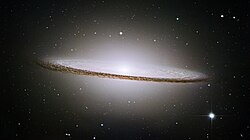Súbor:Sombrero Galaxy in infrared light (Hubble Space Telescope and Spitzer Space Telescope).jpg

Veľkosť tohto náhľadu: 800 × 448 pixelov. Iné rozlíšenia: 320 × 179 pixelov | 640 × 359 pixelov | 1 024 × 574 pixelov | 1 280 × 717 pixelov | 3 000 × 1 681 pixelov .
Pôvodný súbor (3 000 × 1 681 pixelov, veľkosť súboru: 3,98 MB, MIME typ: image/jpeg)
História súboru
Po kliknutí na dátum/čas uvidíte ako súbor vyzeral vtedy.
| Dátum/Čas | Náhľad | Rozmery | Používateľ | Komentár | |
|---|---|---|---|---|---|
| aktuálna | 20:46, 20. júl 2009 |  | 3 000 × 1 681 (3,98 MB) | Tryphon | {{Information |Description=NASA/ESA Hubble Space Telescope and NASA's Spitzer Space Telescope joined forces to create this striking composite image of one of the most popular sights in the universe. Messier 104 is commonly known as the Sombrero galaxy bec |
Použitie súboru
Na tento súbor odkazujú nasledujúce 3 stránky:
Globálne využitie súborov
Nasledovné ďalšie wiki používajú tento súbor:
- Použitie na ast.wikipedia.org
- Použitie na az.wikipedia.org
- Použitie na bs.wikipedia.org
- Použitie na cs.wikipedia.org
- Použitie na de.wikipedia.org
- Použitie na en.wikipedia.org
- Použitie na en.wikiquote.org
- Použitie na en.wikiversity.org
- Použitie na es.wikipedia.org
- Použitie na fa.wikipedia.org
- Použitie na frp.wikipedia.org
- Použitie na fr.wikipedia.org
- Použitie na he.wikipedia.org
- Použitie na id.wikipedia.org
- Použitie na it.wikibooks.org
- Použitie na kk.wikipedia.org
- Použitie na kn.wikipedia.org
- Použitie na mg.wikipedia.org
- Použitie na pl.wikipedia.org
- Použitie na pt.wikipedia.org
- Použitie na simple.wikipedia.org
- Použitie na sv.wikipedia.org
- Použitie na sw.wikipedia.org
Zobraziť ďalšie globálne použitie tohto súboru.


